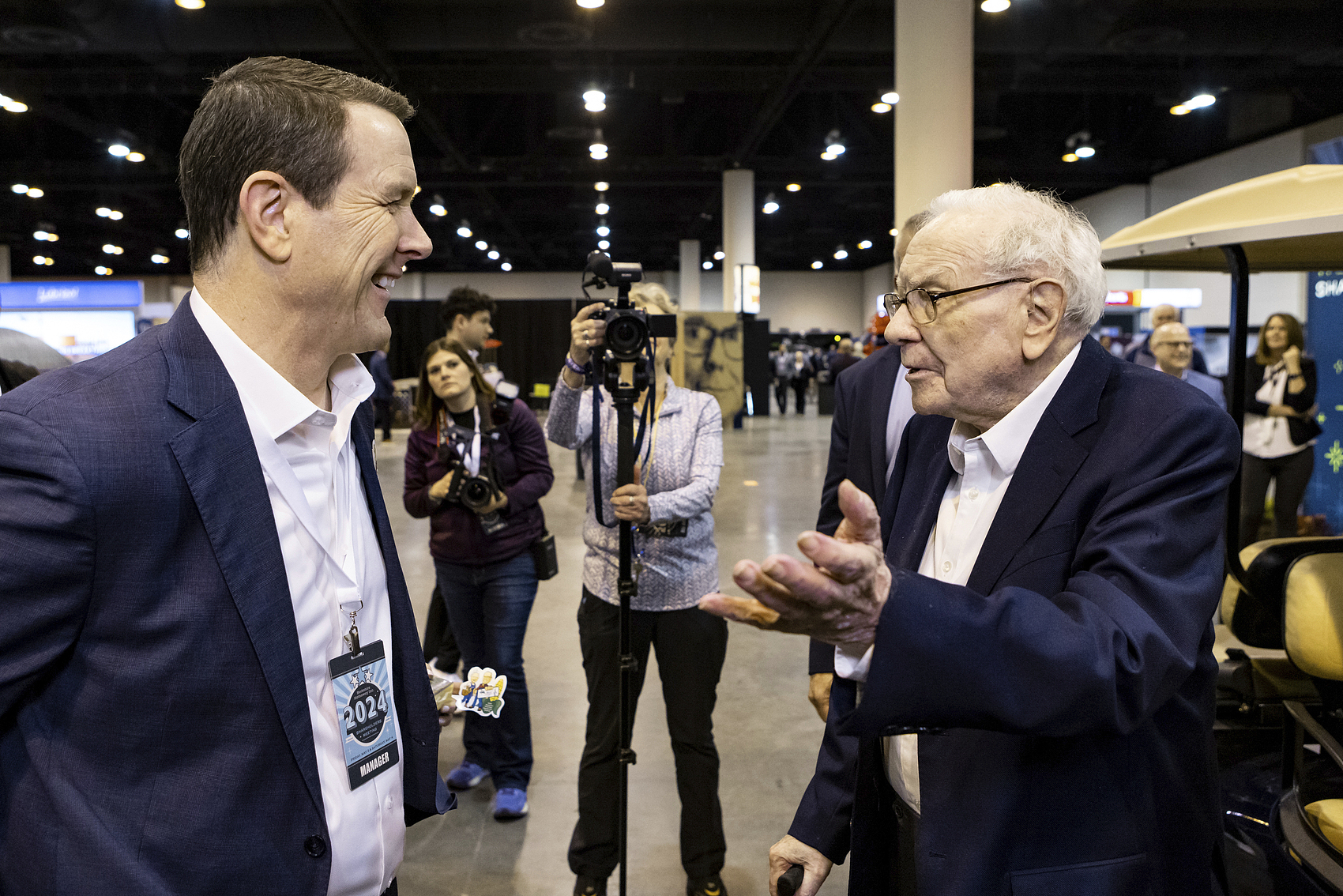Warren Buffett's 5 Investing Mistakes: What Can We Learn?
Warren Buffett's 5 Investing Mistakes: What Can We Learn?
Warren Buffett, widely regarded as one of the most successful investors ever, has built a massive fortune through smart investments and a sharp sense for spotting value. However, even the Oracle of Omaha is not immune to making mistakes. In fact, Buffett himself is candid about his investment blunders and considers them valuable learning experiences. Here, we explore 5 of Buffett’s biggest investing mistakes and the lessons they impart.
禾倫·巴菲特被廣泛認爲是有史以來最成功的投資者之一,通過精明的投資和敏銳的價值觀發現能積累了巨額的財富。然而,即便是奧馬哈的谷歌(Oracle of Omaha)也不免犯錯。事實上,巴菲特本人坦率地承認了自己的投資失誤,並將它們視爲寶貴的學習經驗。在這裏,我們探討巴菲特五大投資錯誤以及它們所傳達的教訓。
1. Dexter Shoe Company
1. 多星鞋業
In 1993, Warren Buffett’s Berkshire Hathaway acquired Dexter Shoe Company for approximately $433 million. Buffett paid for the acquisition with Berkshire Hathaway stock, which, in hindsight, was a costly error. Dexter Shoe, which was initially profitable, soon faced significant challenges due to increased competition from low-cost overseas manufacturers. The company's decline was swift, and it eventually became worthless. Buffett later admitted that the decision to purchase Dexter Shoe with stock was one of his worst mistakes, costing Berkshire shareholders billions as the value of those shares skyrocketed over time.
1993年,禾倫·巴菲特的伯克希爾·哈撒韋(Berkshire Hathaway)以大約43300萬美元收購了多星鞋業。巴菲特用伯克希爾·哈撒韋股票支付了收購款項,回想起來,這是一個代價高昂的錯誤。多星鞋業最初是盈利的,但很快面臨來自低成本境外製造商的激烈競爭,遇到了重重挑戰。該公司的衰落迅猛,最終一文不值。巴菲特後來承認,用股票購買多星鞋業是他犯下的最嚴重的失誤之一,因爲隨着時間推移這些股票的價值飆升,這給伯克希爾的股東造成了數十億美元的損失。
Lesson Learned: The Dexter Shoe failure taught Buffett the importance of assessing the durability of a company's competitive advantage. It also highlighted the potential opportunity cost of using valuable stock as a currency for acquisitions. Investors should be cautious when evaluating companies vulnerable to industry shifts and competitive pressures.
得到的教訓:多星鞋業的失敗教會了巴菲特評估公司競爭優勢的持久性的重要性。它還凸顯了使用有價值的股票作爲收購貨幣所帶來的潛在機會成本。投資者在評估容易受行業變動和競爭壓力影響的公司時應謹慎。
2. Tesco PLC
2. 英國樂購有限公司
Buffett’s investment in Tesco, a British grocery chain, is another example of a misstep. Berkshire Hathaway began purchasing Tesco shares in 2006 and eventually became one of the company's largest shareholders. Initially, the investment appeared promising, but Tesco soon faced accounting scandals and operational difficulties. Buffett was slow to react to the negative developments and began selling his shares only after the problems became too significant to ignore, resulting in an estimated loss of over $400 million.
巴菲特對英國連鎖雜貨店樂購的投資是另一個錯誤的例證。伯克希爾·哈撒韋於2006年開始購買樂購股份,並最終成爲該公司最大的股東之一。最初,這項投資似乎很有前途,但樂購很快面臨會計醜聞和運營困難。巴菲特對負面發展反應遲緩,只有在問題變得過於嚴重以至無法忽視時才開始出售股份,導致預計損失逾40000萬美元。
Lesson Learned: The Tesco experience underscores the importance of vigilance and timely decision-making. Investors must stay informed about their holdings and be ready to act decisively when a company's fundamentals deteriorate. It serves as a reminder that even well-established companies are not immune to mismanagement and scandal.
得到的教訓:樂購的經歷強調了警惕性和及時決策的重要性。投資者必須及時了解自己持有的股票,並準備在公司基本面惡化時果斷採取行動。這提醒人們,即使是實力雄厚的公司也難以避免管理不善和醜聞。

3. US Airways
3. 美國航空
In the late 1980s, Buffett invested in US Airways, attracted by the airline's potential for turnaround and profitability. However, the airline industry proved to be highly volatile and fraught with challenges, including labor disputes and fluctuating fuel prices. US Airways struggled financially, and Buffett later described the industry as a "death trap" for investors. Although Berkshire eventually made a small profit when the airline recovered, the investment was fraught with uncertainty and risk.
上世紀80年代末,巴菲特投資了美國航空,被其潛力和盈利能力所吸引。然而,航空業被證明是極其波動和充滿挑戰的,包括勞資糾紛和燃油價格波動。美國航空在財務上陷入困境,巴菲特後來將該行業描述爲投資者的"死亡陷阱"。儘管伯克希爾最終在航空公司復甦時獲得了微薄利潤,但這筆投資充滿了不確定性和風險。
Lesson Learned: Buffett's US Airways investment highlights the perils of investing in industries plagued by structural issues and high levels of unpredictability. It taught him the importance of understanding industry dynamics and the risks associated with businesses that require significant capital expenditure and are sensitive to external factors. As a result, Buffett has generally avoided airline investments, although he made a notable exception in the 2010s, which he later exited.
所得教訓:巴菲特的美國航空投資突顯了投資受結構問題和高度不可預測性困擾的行業所面臨的危險。它教導他了解行業動態和企業在需要大量資本支出、對外部因素敏感的情況下所面臨的風險的重要性。因此,巴菲特一般避免航空業投資,儘管在2010年代做出了一個引人注目的例外,後來退出。
4. ConocoPhillips
4. 康菲石油
In 2008, Buffett made a significant investment in ConocoPhillips as oil prices were soaring. However, he misjudged the cyclical nature of the energy market. Soon after his investment, oil prices plummeted during the financial crisis, leading to substantial losses for Berkshire Hathaway.
2008年,巴菲特在石油價格飆升時對康菲石油進行了重大投資。然而,他誤判了能源市場的週期性特點。在他投資後不久,石油價格在金融危機期間暴跌,給伯克希爾·哈撒韋造成了巨大損失。
Lesson Learned: This experience highlights the risks of investing based on commodity price speculation. For investors, it emphasizes the necessity of timing and market conditions when considering investments in cyclical industries. Diversification and a margin of safety are crucial.
所得教訓:這段經歷突顯了基於商品價格猜測進行投資的風險。對投資者來說,它強調了在考慮投資週期性行業時對時間和市場條件的必要性。分散投資和保守的安全邊際至關重要。
5. IBM
5. IBM
In 2011, Buffett made headlines when he invested heavily in IBM, a departure from his usual avoidance of technology stocks due to their rapid changes and uncertainties. Buffett believed IBM had a solid business model and significant growth prospects. However, the company struggled to adapt to the changing tech landscape, facing declining revenues and increasing competition. By 2018, Buffett had significantly reduced his stake in IBM, acknowledging that his original thesis had not played out as expected.
2011年,巴菲特在投資IBM上引起轟動,這與他通常避開科技股的策略不同,因爲科技股變化迅速,充滿不確定性。巴菲特相信IBM有穩固的商業模式和顯著的增長前景。然而,該公司在適應不斷變化的科技環境上遇到困難,面臨收入下降和競爭加劇的局面。到了2018年,巴菲特已大幅減持IBM股份,承認他最初的投資論點未按預期發揮。
Lesson Learned: The IBM investment serves as a reminder of the complexities and rapid evolution within the technology sector. Buffett's experience emphasizes the need for thorough understanding and caution when investing in industries outside one's expertise. For investors, sticking to areas where they have a strong knowledge base can help mitigate risks associated with unfamiliar sectors.
所學到的教訓:IBM的投資提醒我們科技行業的複雜性和迅速變化。巴菲特的經歷強調了在投資超出自己專業領域的行業時,需要深入了解和謹慎行事。對投資者來說,堅持在自己熟悉的領域投資可以幫助降低對陌生行業的風險。
Conclusion
結論
The key takeaway from Buffett's experiences is the importance of continuous learning and adaptability. By acknowledging and analyzing past missteps, investors can refine their strategies and improve decision-making processes. Emphasizing the significance of understanding competitive advantages, industry dynamics, and company fundamentals, Buffett's journey underscores the value of patience, discipline, and a long-term perspective in the world of investing. As we navigate our own investment paths, let us remember Buffett's wisdom and strive for informed, thoughtful, and resilient investment practices.
從巴菲特的經歷中得出的關鍵啓示在於持續學習和適應的重要性。通過承認和分析過去的失誤,投資者可以改進他們的策略並完善決策過程。強調了理解競爭優勢、行業動態和公司基本面的重要性,巴菲特的旅程強調了投資世界中耐心、紀律和長遠觀念的價值。在我們探索自己的投資道路時,讓我們銘記巴菲特的智慧,力求進行明智、思考周到和有彈性的投資實踐。


 Buffett’s investment in Tesco, a British grocery chain, is another example of a misstep. Berkshire Hathaway began purchasing Tesco shares in 2006 and eventually became one of the company's largest shareholders. Initially, the investment appeared promising, but Tesco soon faced accounting scandals and operational difficulties. Buffett was slow to react to the negative developments and began selling his shares only after the problems became too significant to ignore, resulting in an estimated loss of over $400 million.
Buffett’s investment in Tesco, a British grocery chain, is another example of a misstep. Berkshire Hathaway began purchasing Tesco shares in 2006 and eventually became one of the company's largest shareholders. Initially, the investment appeared promising, but Tesco soon faced accounting scandals and operational difficulties. Buffett was slow to react to the negative developments and began selling his shares only after the problems became too significant to ignore, resulting in an estimated loss of over $400 million.